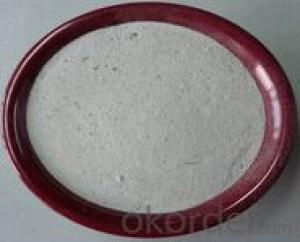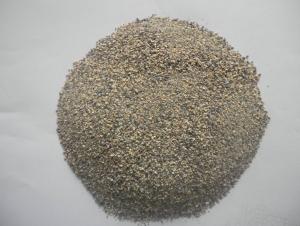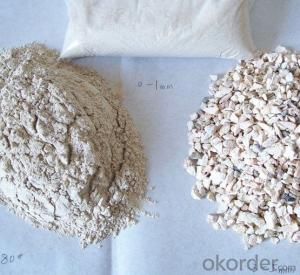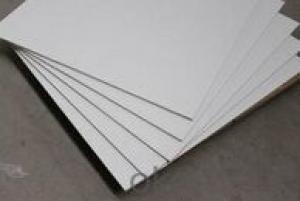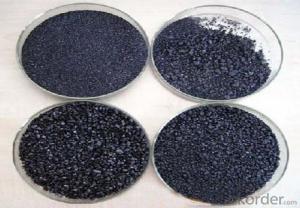High Quality Refractory Cenospheres - Raw Materials for Refractory
- Loading Port:
- China Main Port
- Payment Terms:
- TT OR LC
- Min Order Qty:
- -
- Supply Capability:
- -
OKorder Service Pledge
OKorder Financial Service
You Might Also Like
Cenosphere, sometimes called microsphere, is a light weight, inert, hollow sphere made largely of silica and alumina and filled with air or inert gas., typically produced as a byproduct of coalcombustion at thermal power plants. The color varies from gray to almost white and their density is about 0.6–0.9 g/cm³, all these property give it a widely application for insulation,refractory,oil drilling,coating,construction use.
1, Company Introduction,
----We as the only Asia director of TVA and ISO 9001:, have been dealing non-metallic minerals for nearly 20years, with a strict quality control and sincere service, our cenosphere has enjoyed a popular market in Australia,New Zealand, USA,Japan,Korea,Thailand etc, also hope to serve you this time with our products and service.
2, Specifications,
Specs/Grade | Grade1 | Grade2 | Grade3 | Grade4 | Grade5 |
True Density(g/cc) | 0.6-0.7 | 0.7-0.85 | 0.85MAX | 0.8-0.9 | 0.9-1.0 |
Bulk Density(g/cc) | 0.37-0.40 | 0.38-0.41 | 0.39-0.42 | 0.40-0.43 | 0.45-0.5 |
Compress Strength(Mpa) | 20-40 | 40-60 | 40-80 | 40-80 | 50-100 |
Size(micron) | 40-300 | 40-300 | 40-300 | 40-300 | 40-300 |
Float Ratio | 95%min | 95%min | 95%min | 95%min | 95%min |
PH | 7-8 | 7-8 | 7-8 | 7-8 | 7-8 |
Thermal Conductivity(w/m.k) | 0.036-0.060 | 0.036-0.060 | 0.036-0.060 | 0.036-0.060 | 0.036-0.060 |
Refractoriness | 1100-1660°C | 1100-1660°C | 1100-1660°C | 1100-1660°C | 1100-1660°C |
Color | Grey/White | Grey/White | Grey/White | Grey/White | Grey/White |
Moisture | 2%MAX | 2%MAX | 2%MAX | 2%MAX | 2%MAX |
Kraft Packing | 20KG | 20KG | 20KG | 25KG | 25KG |
Packing-2 | 400KG | 400KG | 450KG | 500KG | 500KG |
3, Typical Applications,
1), Chemicals/Coating/Painting --- Provide measuring tool in biology and drug research, besides added to paints and epoxies to modify viscosity and buoyancy ;
2), Plastics --- Used to decrease material density (glass and polymer);
3), Ceramics --- Used to create porous ceramics used for filters;
4), Cosmetics --- Used to hide wrinkles and give color;
5), Electronic paper --- Dual Functional microspheres used in Gyricon electronic paper
6), Insulation --- expandable polymer microspheres are used for thermal insulation and sound dampening.
7), Retroreflective --- added on top of paint used on roads and signs to increase night visibility of road stripes and signs;
4,Some pictures about our cenosphere for your checking,
1: Floating Tank,
Any interests on our cenosphere/microsphere, pls feel free to let us know, hope to serve you soon.
Best regards.
FACTORY:


- Q: What does fire-resistant insulation coating have?
- Refractory thermal insulation material mainly refers to the inorganic thermal insulation material and composite thermal insulation material. According to the shape, it can be divided into: Finishing of fibrous shape, mineral?cotton, rock wool, glass wool, aluminum?silicate?wool, ceramic fiber, etc. Diatomaceous earth of microporous pile, calcium silicate, expanded perlite,expanded vermiculite,aerated concrete, etc. Foam glass of bubble shape, volcanic ash glass, foamed clay, foamed?concrete, gelatine powder polyphenyl granule heat insulating slurry of pasty form, etc. Their common feature is fire-retardant and firproof. It can be used in buildings with high requirements of fire?rating. Calcium silicate, aluminum silicate and asbestos can also be used for piping insulation of heat transport with high temperature.
- Q: How to hang the suspended brick in the refractory masonry?
- First you can weld the metal fastener of the suspended brick and then hang up the brick.
- Q: What's the definition of fire endurance of the fire-resistant coating for steel structure?
- 1. Fire endurance. Conduct fire resistance test of any building component according to the standard time-temperature curve, and the time when it is subjected to the fire to the time when it loses support capability or fire insulation function or its integrality is destroyed is referred to fire endurance. 2. Steel has relatively low fire endurance which is usually 0.25h only, namely 15 minutes; 3. Of steel structure buildings, steel can be used as beams, pillars, etc. but its fire endurance is not enough (usually these components have higher requirement on fire endurance, and take pillar as an example, it is usually demanded that the fire endurance should be 2-3h), and under this condition, it needs to brush fire retardant coating so as to raise the fire endurance. As to the specific quantity or types of the fire retardant coating, it is decided upon the actual conditions. In short, the building material needs to meet the required fire endurance of the buildings.
- Q: What is the classification standard of fireproofing material levels?
- the following are the criteria: Currently fire materials levels mainly include:class A : incombustible building material,which almost doesn't burn. class A1: non-combustible, without open fire, class A2, non-combustible, it needs to measure the smoke and be qualified. class B1: nonflammable building material: nonflammable materials have good flame resistance function. when it contacts open fire or is under high temperature, it's difficult to burn and be spreading rapidly, and will stop burn after removing the combustion?source. class B1: combustible?building?materials: combustible materials have good flame resistance function. when it contacts open fire or is put in the air at high temperature, it will immediately burst into flames, and easily result in the spreading of fire, such as wooden column, timber roof truss, timber beam, wooden stairs, etc. class B3: inflammability building materials, without any flame resisting effects, easy to burn, and has large danger of fire disaster. In addition, according to different standards, fire-proofing materials' grade partition is different: DIN4102: A1, A2, B1, B2, B3: EN13501-1 A1, A2, B, C, D, E, F
- Q: Is there vermiculite in refractory?
- Vermiculite is usually used as lightweight material in refractory field, and its volume density is about 0.5.
- Q: How to determine the fire resistance rating of the aluminium-plastic?panel?
- The fire resistance rating of the aluminium-plastic?panel is determined by two indicators, namely national compulsory standard of GB8624 "Building Materials Combustion Performance Grading Method ", and GB/T17748 "Aluminium-plastic?Composite Panel National Standard" . Classifications of combustion performance of building materials in our country are as follows: A class: Incombustible building materials; B1 class: Flame-retardant building materials; B2 class: combustible building material; B3 class: flammable building materials. The fire resistance rating of the aluminium-plastic composite panel shuld be no less than B1 class. 1. Detection indexes and requirements of fireproof aluminum-plastic composite panel (B1 class): (1) Conduct the test according to GB/T8625-88, the average leftover length of each test specimen should be more than 150mm, (any test piece should have leftover length), and the maximum average flue gas temperature of each test should be no more than 200 ℃; (2) Conduct the test according to GB/T8626-88, flame hight indicators.
- Q: Selection of refractory materials?
- Inorganic non-metallic material with a refractoriness of more than 1580 degrees. Refractoriness refers to the temperature of a sample of a refractory cone, which is resistant to high temperature without softening, and does not soften and melt down. Refractory materials are associated with high temperature technology, which originated roughly from the middle of the bronze age. In the Eastern Han Dynasty has made China kiln firing porcelain material and with fireclay refractory sagger. In the early twentieth Century, refractory materials were developed towards high purity, high density and ultra high temperature products. At the same time, unshaped refractory materials and refractory fibers without firing and energy consumption were developed. With the development of modern technology, atomic energy, space technology, new energy technology, refractory material having high temperature resistance and corrosion resistance, thermal shock resistance, erosion resistance and other comprehensive excellent performance has been applied.
- Q: What are the differences and connections between softening temperature of the refractory under a fixed load and thermal resistant creep property of the refractory?
- The result of refractoriness under load is temperature while the result of creep is percentage of deformation. Refractoriness under load and creep can be tested by an instrument. Refractoriness under load reflects the temperature in which the deformation reaches a certain degree under the condition of load. Creep reflects the deformation refractory has under the condition of constant temperature and load. Both refractoriness under load and creep are important criterion for the operating temperature of refractory.
- Q: Does anyone know about the classification standards of B2-level fireproof and thermal insulation materials?
- The fire-resistant differences of B1- and B2-level extruded insulation boards are as follow: B1-level materials will be smothered as soon as staying away from fire, namely, they will be extinguished after leaving fire, or be put out in 10 seconds. B2-level materials will be in low-grade combustion, namely, the fire will not get wilder, and drippings will not ignite the filter paper. I hope my answer can help you!
- Q: How to classify fire resistance rating of brick-concrete structure?
- In order to ensure the safety of the building, the fire protection measures must be taken to make it have a certain degree of fire resistance, even if there is a fire, it will not cause too much damage. According to the national conditions of our country, and in the light of other countries standards, < high-rise civil building fire protection design specification > defines fireproof rank of high-rise civil buildings into level one and two; < code for fire protection design of buildings > divides the rank into level one, two, three, four, level one is the highest level, level four is the lowest. Besides that the minimum fire resistance of the building component is specified, buildings of fire resistance rating also specified requirements for combustion performance. Because the component with the same fire resistance limit is different, it is different in the fire.According to our country national standard < building design fire protection code >, the fire resistance rating of the building is divided into four levels. The fire resistance of a building is determined by the combustion performance and fire resistance of building components (such as beams, columns, floors, walls, etc.). Generally speaking, the fire resistance building of level one is a mixed structure of reinforced concrete structure or a mixture of brick wall and steel concrete structure; the fire resistance building of level two is a mixed structure of steel truss structure, reinforced concrete column and brick wall; the fire resistance building of level three is brick-wood structure made of wood roof and brick wall; the fire resistance building of level four is combustible structure which is composed of wood roof and non-combustible wall.
Send your message to us
High Quality Refractory Cenospheres - Raw Materials for Refractory
- Loading Port:
- China Main Port
- Payment Terms:
- TT OR LC
- Min Order Qty:
- -
- Supply Capability:
- -
OKorder Service Pledge
OKorder Financial Service
Similar products
Hot products
Hot Searches
Related keywords
